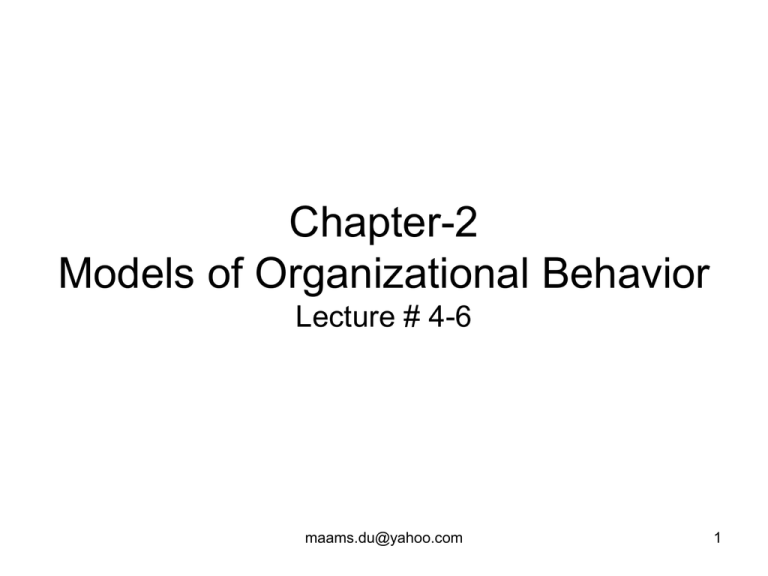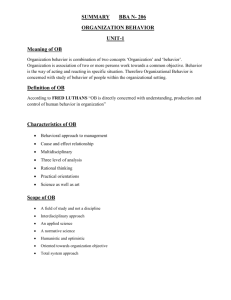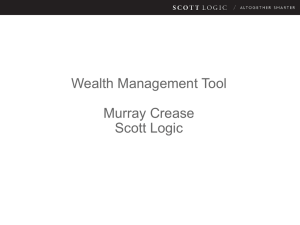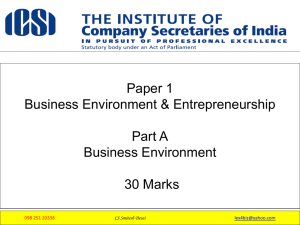Chapter-2 Models of Organizational Behavior
advertisement

Chapter-2 Models of Organizational Behavior Lecture # 4-6 maams.du@yahoo.com 1 An organizational Behavior System Organizations achieve their goals by creating, communicating, and operating an organizational behavior system. The primary purposes of organizational behavior systems are to identify and then help manipulate the major human and organizational variables that affect the results organizations are trying to achieve. maams.du@yahoo.com 2 Elements of the System a) The philosophy and values: It means an integrated set of assumptions and beliefs about the way things are of the organization, the purposes of these activities and the way they should be. The philosophies may be –autocratic, custodial, supportive etc. The philosophy of organizational behavior originated from two sources- Fact premises and Value premises. 1. Fact premises represent our descriptive view of how the world behaves. They are drawn from both behavioral science research and our personal experiences. maams.du@yahoo.com 3 2. Value premises represent our view of the desirability of certain goals and objectives . These are a variable beliefs we hold and therefore under our control. b) Vision: It means a challenging portrait of what the organization and its members can be a possible and desirable future. It basically focused on achieving long-term goals and objectives. c) Mission: It identifies the business it is in the market niches it tries to serve the types of customers it is likely to have, and the reasons for its existence. In contrast to vision, mission statements are more descriptive and less future oriented. maams.du@yahoo.com 4 d) Goal: Goals are relatively concrete formulations of achievements the organization is aiming for within set periods of time, i.e.. one to five years. Goals may exist at the individual , group and larger organizational level. Goals are more specific. maams.du@yahoo.com 5 An Organizational Behavior System Management’s Philosophy, Values, Vision, Mission, Goals Formal Organization Informal Organization Organizational Culture Social Environment Leadership, Communication Group dynamics Quality of work life Motivation Outcomes: 1. Performance 2. Employee satisfaction maams.du@yahoo.com 3. Persona, growth & development 6 Philosophy , values, vision, mission, goals all help to create a recognizable organizational culture. This culture also a reflection of the formal organization with its formal policies, structures and procedures and the existing social and cultural environment. The formal and informal organizations provide the glue that binds the varied elements of the institution into an effective working team. Managers are then expected to use a leadership style, communications skills and their knowledge of interpersonal and group dynamics to create an appropriate quality of work life for the employees. maams.du@yahoo.com 7 Theory X, Theory Y: In his 1960 book, The Human Side of Enterprise, Douglas McGregor proposed two theories by which to view employee motivation. He avoided descriptive labels and simply called the theories Theory X and Theory Y. Both of these theories begin with the premise that management's role is to assemble the factors of production, including people, for the economic benefit of the firm. Beyond this point, the two theories of management diverge. maams.du@yahoo.com 8 Theory X assumes that the average person: 1. Dislikes work and attempts to avoid it. 2. Has no ambition, wants no responsibility, and would rather follow than lead. 3. Is self-centered and therefore does not care about organizational goals. 4. Resists change. 5. Is gullible and not particularly intelligent. maams.du@yahoo.com 9 Theory Y makes the following general assumptions: 1. Work can be as natural as play and rest. 2. People will be self-directed to meet their work objectives if they are committed to them. 3. People will be committed to their objectives if rewards are in place that address higher needs such as self-fulfillment. 4.Under these conditions, people will seek responsibility. 5. Most people can handle responsibility because creativity and ingenuity are common in the population. maams.du@yahoo.com 10 1. 2. 3. 4. 5. Models of OB Autocratic Model Custodial Model Supportive Model Collegial Model System Model maams.du@yahoo.com 11 1. Autocratic Model: Autocratic model depends on power. The people who are in command must have the power to demand “you do this or else”, meaning that an employee who does not follow order will be penalizes. In the autocratic environment the managerial orientation is formal, official, authority. This authority is delegated by right of command over the people to whom it applies. maams.du@yahoo.com 12 Management believes that it knows what is best and that the employee’s obligation is to follow orders. It assumes that employees have to directed, and pushed into performance and such prompting is management’s task. Under autocratic conditions the employee orientation is obedience to boss not respect for a manager. The psychological result for employees is dependence on their boss, whose power to hire , fire etc. maams.du@yahoo.com 13 2. Custodial Model: In autocratic model employees did not talk back to their boss, but they certainly thought back. A successful custodial approach depends on economic resources. The resulting managerial orientation is toward money to pay wages and benefits. Since employees’ physical needs are already reasonably met, the employer looks to security needs as a motivating force. If an organization does not have the wealth to provide pensions and pay other benefits, it cannot follow a custodial approach. maams.du@yahoo.com 14 The custodial approach leads to employee dependence on the organization. Rather than being dependent on their boss for their weekly bread, employees now depend on organizations for their security and welfare. The custodial model is describe in its extreme in order to show its emphasis on material rewards, security, and organizational dependence. maams.du@yahoo.com 15 3. Supportive Model: The supportive model of organizational behavior had its origins in the “principle of supportive relationships”. It depends on leadership instead of power or money . Through leadership, management provides a climate to hope employees grow and accomplish in the interests of the organization the things of which theft are capable. maams.du@yahoo.com 16 The leader assumes that workers are not by nature passive and resisted to organizational needs, but that they are made so by an inadequately supportive climate at work. They will take responsibility , develop a drive to contribute, and improve themselves if management will give them a chance. Here management’s concentration is to support the employee’s job performance rather than to simply support employee benefit payments as in the custodial approach. Employee says “we” instead of “they” when referring to their organization. maams.du@yahoo.com 17 4. Collegial Model: A useful extension of the supportive model is the collegial model. The term “collegial” relates to a body of people working together cooperatively. The collegial model embodies a team concept. The collegial model depends on management’s building a feeling of partnership with employees. The result is that employees feel needed and useful. They feel that managers are contributing also , so it is easy to accept and respect their roles in the organization. Managers are seen as joint contributors rather than as bosses. maams.du@yahoo.com 18 The managerial orientation is toward teamwork and management is the coach that builds a better team. The employee response to this situation is responsibility. 5. System Model: Under the system model managers try to convey to each worker, “you are an important part of our whole system. We sincerely care about each of you. We want to join together to achieve a better product or service, local community and society at large. We will make every effort to make products that are environmentally friendly.” maams.du@yahoo.com 19 The role of a manager becomes one of facilitating employee accomplishments through a variety of actions. These actions are 1. Support employee commitment to short-and long-term goals. 2. Coach individuals and groups in appropriate skills and behaviors. 3.Model and foster self-esteem. 4. Show genuine concern and empathy for people. 5. Offer timely and acceptable feedback. 6. Help individuals identify and confront issues in ethical ways. maams.du@yahoo.com 20










